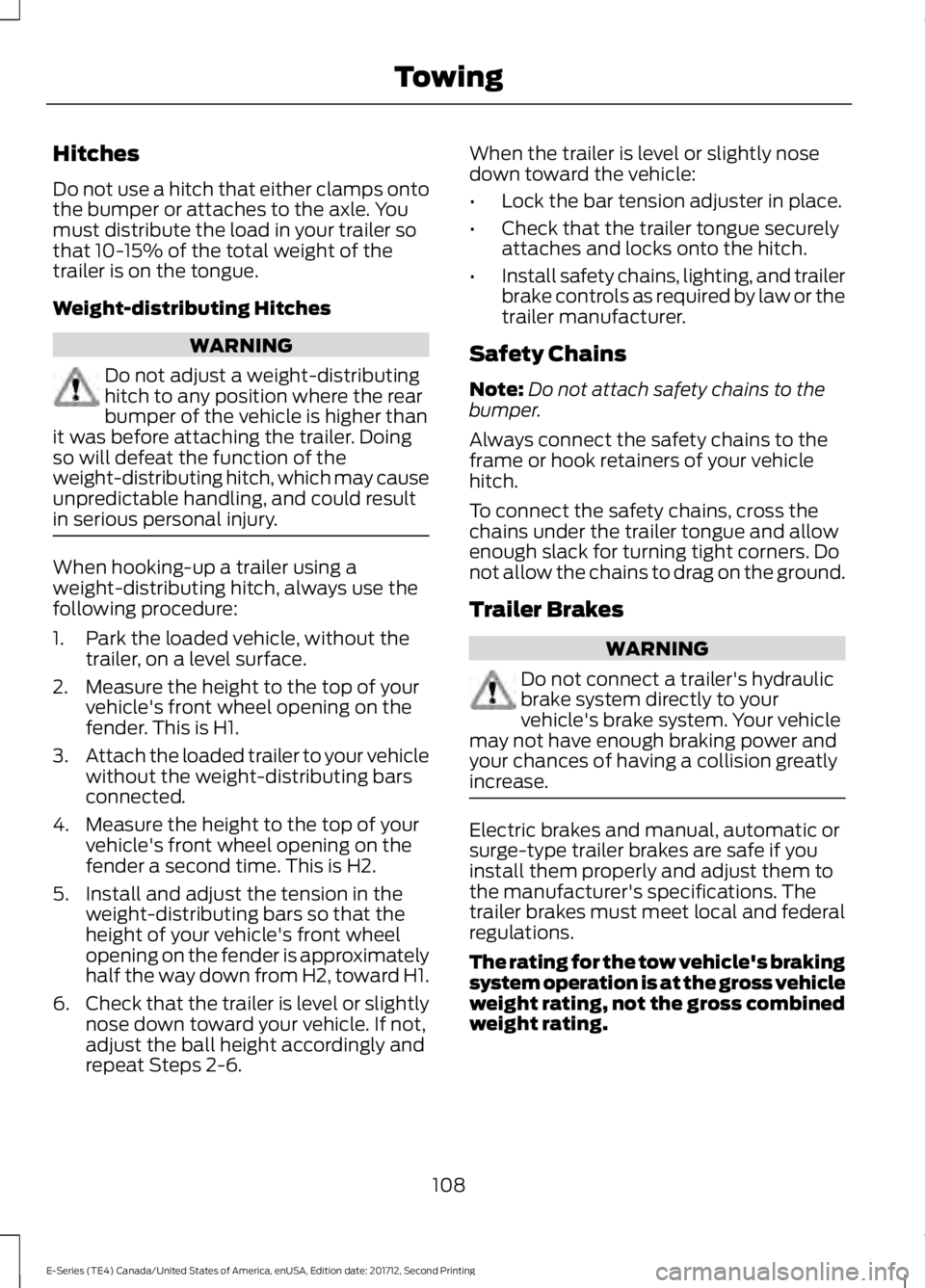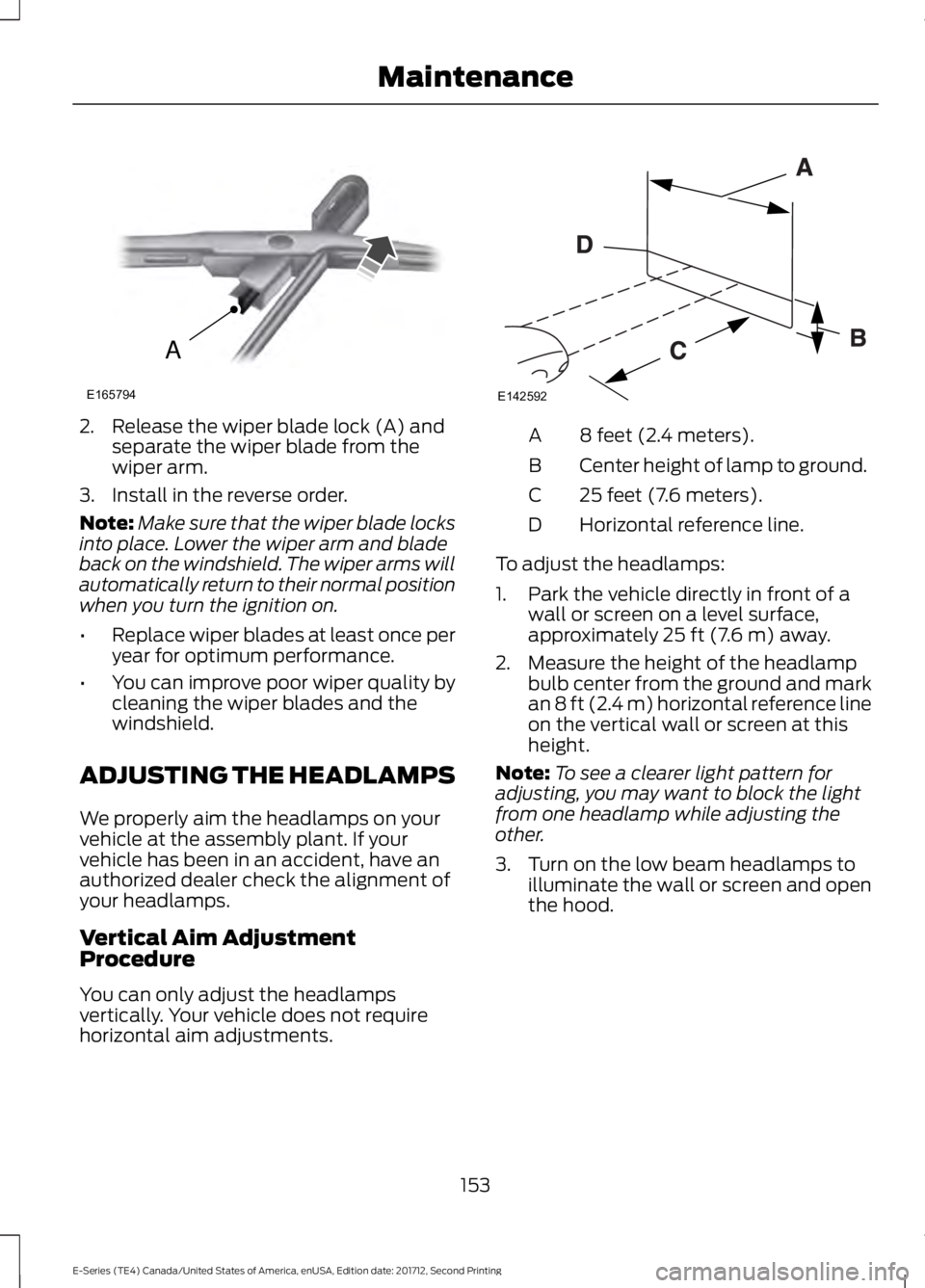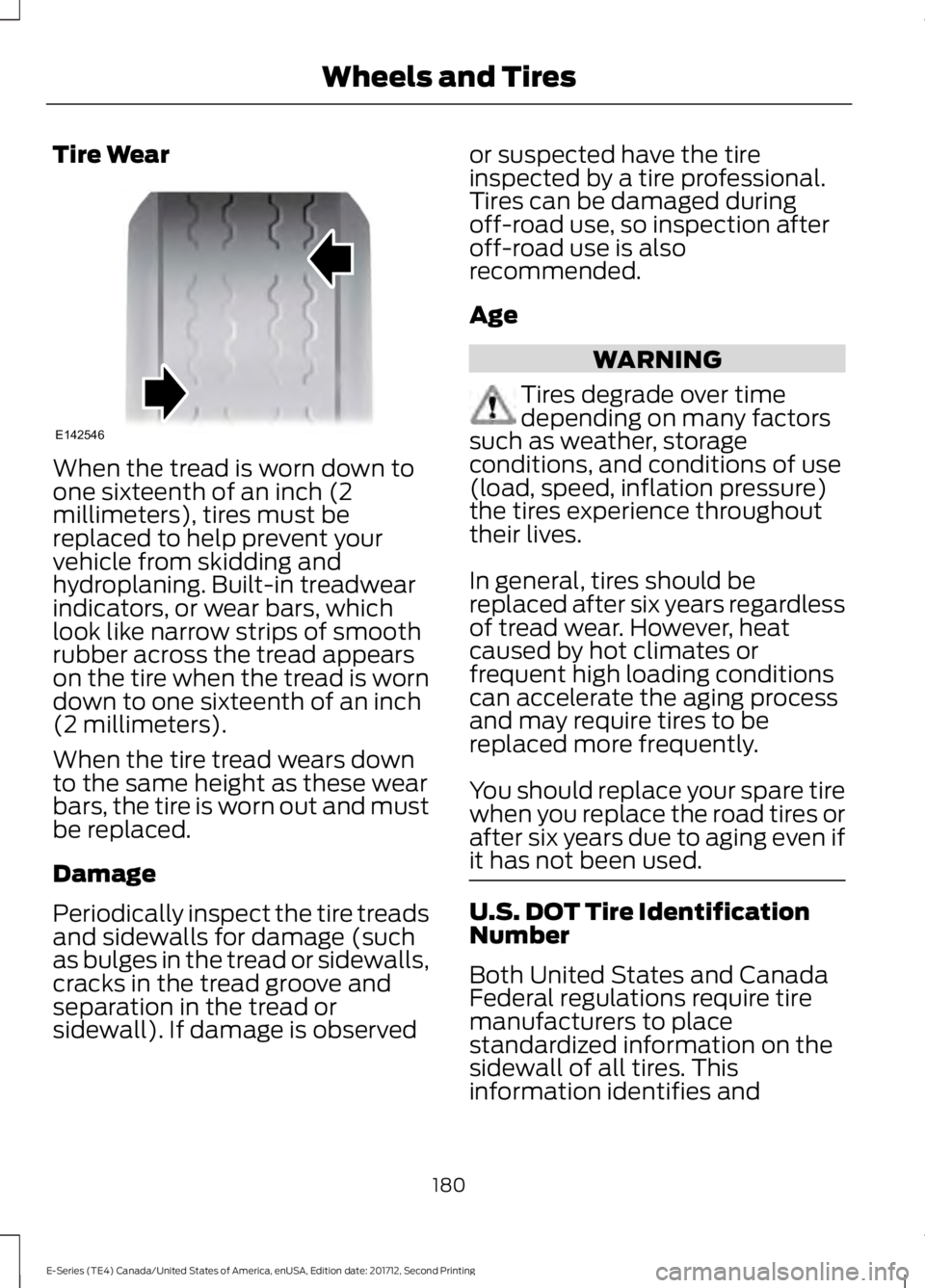2018 FORD E-350 height
[x] Cancel search: heightPage 111 of 323

Hitches
Do not use a hitch that either clamps onto
the bumper or attaches to the axle. You
must distribute the load in your trailer so
that 10-15% of the total weight of the
trailer is on the tongue.
Weight-distributing Hitches
WARNING
Do not adjust a weight-distributing
hitch to any position where the rear
bumper of the vehicle is higher than
it was before attaching the trailer. Doing
so will defeat the function of the
weight-distributing hitch, which may cause
unpredictable handling, and could result
in serious personal injury. When hooking-up a trailer using a
weight-distributing hitch, always use the
following procedure:
1. Park the loaded vehicle, without the
trailer, on a level surface.
2. Measure the height to the top of your vehicle's front wheel opening on the
fender. This is H1.
3. Attach the loaded trailer to your vehicle
without the weight-distributing bars
connected.
4. Measure the height to the top of your vehicle's front wheel opening on the
fender a second time. This is H2.
5. Install and adjust the tension in the weight-distributing bars so that the
height of your vehicle's front wheel
opening on the fender is approximately
half the way down from H2, toward H1.
6. Check that the trailer is level or slightly
nose down toward your vehicle. If not,
adjust the ball height accordingly and
repeat Steps 2-6. When the trailer is level or slightly nose
down toward the vehicle:
•
Lock the bar tension adjuster in place.
• Check that the trailer tongue securely
attaches and locks onto the hitch.
• Install safety chains, lighting, and trailer
brake controls as required by law or the
trailer manufacturer.
Safety Chains
Note: Do not attach safety chains to the
bumper.
Always connect the safety chains to the
frame or hook retainers of your vehicle
hitch.
To connect the safety chains, cross the
chains under the trailer tongue and allow
enough slack for turning tight corners. Do
not allow the chains to drag on the ground.
Trailer Brakes WARNING
Do not connect a trailer's hydraulic
brake system directly to your
vehicle's brake system. Your vehicle
may not have enough braking power and
your chances of having a collision greatly
increase. Electric brakes and manual, automatic or
surge-type trailer brakes are safe if you
install them properly and adjust them to
the manufacturer's specifications. The
trailer brakes must meet local and federal
regulations.
The rating for the tow vehicle's braking
system operation is at the gross vehicle
weight rating, not the gross combined
weight rating.
108
E-Series (TE4) Canada/United States of America, enUSA, Edition date: 201712, Second Printing Towing
Page 156 of 323

2. Release the wiper blade lock (A) and
separate the wiper blade from the
wiper arm.
3. Install in the reverse order.
Note: Make sure that the wiper blade locks
into place. Lower the wiper arm and blade
back on the windshield. The wiper arms will
automatically return to their normal position
when you turn the ignition on.
• Replace wiper blades at least once per
year for optimum performance.
• You can improve poor wiper quality by
cleaning the wiper blades and the
windshield.
ADJUSTING THE HEADLAMPS
We properly aim the headlamps on your
vehicle at the assembly plant. If your
vehicle has been in an accident, have an
authorized dealer check the alignment of
your headlamps.
Vertical Aim Adjustment
Procedure
You can only adjust the headlamps
vertically. Your vehicle does not require
horizontal aim adjustments. 8 feet (2.4 meters).
A
Center height of lamp to ground.
B
25 feet (7.6 meters).
C
Horizontal reference line.
D
To adjust the headlamps:
1. Park the vehicle directly in front of a wall or screen on a level surface,
approximately 25 ft (7.6 m) away.
2. Measure the height of the headlamp bulb center from the ground and mark
an
8 ft (2.4 m) horizontal reference line
on the vertical wall or screen at this
height.
Note: To see a clearer light pattern for
adjusting, you may want to block the light
from one headlamp while adjusting the
other.
3. Turn on the low beam headlamps to illuminate the wall or screen and open
the hood.
153
E-Series (TE4) Canada/United States of America, enUSA, Edition date: 201712, Second Printing MaintenanceA
E165794 E142592
Page 173 of 323

Information Contained on the
Tire Sidewall
Both United States and Canada
Federal regulations require tire
manufacturers to place
standardized information on the
sidewall of all tires. This
information identifies and
describes the fundamental
characteristics of the tire and also
provides a U.S. DOT Tire
Identification Number for safety
standard certification and in case
of a recall.
Information on P Type Tires
P215/65R15 95H is an example of
a tire size, load index and speed
rating. The definitions of these
items are listed below. (Note that
the tire size, load index and speed
rating for your vehicle may be
different from this example.) A.
P: Indicates a tire, designated
by the Tire and Rim Association,
that may be used for service on
cars, sport utility vehicles,
minivans and light trucks. Note:
If
your tire size does not begin with
a letter this may mean it is
designated by either the European
Tire and Rim Technical
Organization or the Japan Tire
Manufacturing Association.
B. 215:
Indicates the nominal
width of the tire in millimeters
from sidewall edge to sidewall
edge. In general, the larger the
number, the wider the tire.
C. 65:
Indicates the aspect ratio
which gives the tire's ratio of
height to width.
D. R:
Indicates a radial type tire.
E. 15:
Indicates the wheel or rim
diameter in inches. If you change
your wheel size, you have to
purchase new tires to match the
new wheel diameter.
F. 95:
Indicates the tire's load
index. It is an index that relates to
how much weight a tire can carry.
You may find this information in
your owner ’s manual. If not,
contact a local tire dealer.
Note: You may not find this
information on all tires because it
is not required by federal law.
170
E-Series (TE4) Canada/United States of America, enUSA, Edition date: 201712, Second Printing Wheels and TiresH
I
J
KL
M
A
B
CDEFG
E142543
Page 177 of 323

T type tires have some additional
information beyond those of P
type tires. These differences are
described below:
A.
T: Indicates a type of tire,
designated by the Tire and Rim
Association, that is intended for
temporary service on cars, sport
utility vehicles, minivans and light
trucks.
B. 145:
Indicates the nominal
width of the tire in millimeters
from sidewall edge to sidewall
edge. In general, the larger the
number, the wider the tire. C.
80:
Indicates the aspect ratio
which gives the tire's ratio of
height to width. Numbers of 70 or
lower indicate a short sidewall.
D. D:
Indicates a diagonal type tire.
R:
Indicates a radial type tire.
E. 16:
Indicates the wheel or rim
diameter in inches. If you change
your wheel size, you have to
purchase new tires to match the
new wheel diameter.
Location of the Tire Label
You can find a Tire Label
containing tire inflation pressure
by tire size and other important
information located on the B-Pillar
or the edge of the driver's door.
Inflating Your Tires
Safe operation of your vehicle
requires that your tires are
properly inflated. Remember that
a tire can lose up to half of its air
pressure without appearing flat.
Every day before you drive, check
your tires. If one looks lower than
the others, use a tire gauge to
check pressure of all tires and
adjust if required.
At least once a month and before
long trips, inspect each tire and
check the tire pressure with a tire
gauge (including spare, if
equipped). Inflate all tires to the
inflation pressure recommended
by Ford Motor Company.
174
E-Series (TE4) Canada/United States of America, enUSA, Edition date: 201712, Second Printing Wheels and TiresA
BCDE
E142545
Page 183 of 323

Tire Wear
When the tread is worn down to
one sixteenth of an inch (2
millimeters), tires must be
replaced to help prevent your
vehicle from skidding and
hydroplaning. Built-in treadwear
indicators, or wear bars, which
look like narrow strips of smooth
rubber across the tread appears
on the tire when the tread is worn
down to one sixteenth of an inch
(2 millimeters).
When the tire tread wears down
to the same height as these wear
bars, the tire is worn out and must
be replaced.
Damage
Periodically inspect the tire treads
and sidewalls for damage (such
as bulges in the tread or sidewalls,
cracks in the tread groove and
separation in the tread or
sidewall). If damage is observed or suspected have the tire
inspected by a tire professional.
Tires can be damaged during
off-road use, so inspection after
off-road use is also
recommended.
Age
WARNING
Tires degrade over time
depending on many factors
such as weather, storage
conditions, and conditions of use
(load, speed, inflation pressure)
the tires experience throughout
their lives.
In general, tires should be
replaced after six years regardless
of tread wear. However, heat
caused by hot climates or
frequent high loading conditions
can accelerate the aging process
and may require tires to be
replaced more frequently.
You should replace your spare tire
when you replace the road tires or
after six years due to aging even if
it has not been used. U.S. DOT Tire Identification
Number
Both United States and Canada
Federal regulations require tire
manufacturers to place
standardized information on the
sidewall of all tires. This
information identifies and
180
E-Series (TE4) Canada/United States of America, enUSA, Edition date: 201712, Second Printing Wheels and TiresE142546
Page 321 of 323

Scheduled Maintenance Record............277
Scheduled Maintenance...........................270
Seatbelt Extension........................................29
Seatbelt Height Adjustment......................27
Seatbelts...........................................................25 Principle of Operation......................................... 25
Seatbelt Warning Lamp and Indicator Chime..............................................................28
Conditions of operation..................................... 28
Seats...................................................................68
Security..............................................................43
Sitting in the Correct Position...................68
Snow Chains See: Using Snow Chains.................................. 185
Spare Wheel See: Changing a Road Wheel........................ 189
Special Notices
................................................10
New Vehicle Limited Warranty........................ 10
Notice to Owners of Pickup Trucks and Utility Type Vehicles......................................... 11
On Board Diagnostics Data Link Connector
............................................................. 11
Special Instructions............................................. 10
Using your Vehicle as an Ambulance..............11
Special Operating Conditions Scheduled Maintenance...............................................275
Exceptions............................................................. 277
Speed Control See: Cruise Control.............................................. 95
Starter Switch See: Ignition Switch............................................. 73
Starting a Gasoline Engine..........................73 Failure to Start....................................................... 74
Guarding Against Exhaust Fumes.................. 74
Important Ventilating Information.................74
Stopping the Engine When Your Vehicle is Moving.................................................................. 74
Stopping the Engine When Your Vehicle is Stationary........................................................... 74
Starting and Stopping the Engine............73 General Information............................................ 73
Steering.............................................................96
Steering Wheel
...............................................45
Sun Visors.........................................................50
Illuminated Vanity Mirror................................... 50
Supplementary Restraints System.........30 Principle of Operation........................................ 30
Symbols Glossary.............................................5 SYNC™ Applications and Services.......237
911 Assist................................................................ 237
SYNC Services: Traffic, Directions & Information (TDI) (If Equipped, United
States Only)..................................................... 241
Vehicle Health Report (If Equipped, United States Only).................................................... 239
SYNC™ AppLink ™
......................................245
SYNC Mobile Apps............................................ 245
SYNC™.............................................................219 General Information.......................................... 219
SYNC™ Troubleshooting.........................256
T
Technical Specifications See: Capacities and Specifications.............194
The Better Business Bureau (BBB) Auto Line Program (U.S. Only)........................124
Tire Care
...........................................................167
Glossary of Tire Terminology......................... 169
Information About Uniform Tire Quality Grading............................................................... 167
Information Contained on the Tire Sidewall............................................................. 170
Temperature A B C............................................. 168
Traction AA A B C............................................... 168
Treadwear............................................................. 168
Tire Pressure Monitoring System...........186 Changing Tires With a Tire Pressure
Monitoring System........................................ 187
Understanding Your Tire Pressure Monitoring System ....................................... 187
Tires See: Wheels and Tires...................................... 166
Towing a Trailer.............................................102 Load Placement................................................. 102
Towing the Vehicle on Four Wheels.......113 Emergency Towing.............................................. 113
Recreational Towing........................................... 113
Towing..............................................................102
Traction Control
..............................................92
Principle of Operation........................................ 92
Trailer Sway Control
....................................103
Transmission Code Designation.............198
Transmission...................................................86
Transporting the Vehicle.............................121
318
E-Series (TE4) Canada/United States of America, enUSA, Edition date: 201712, Second Printing Index